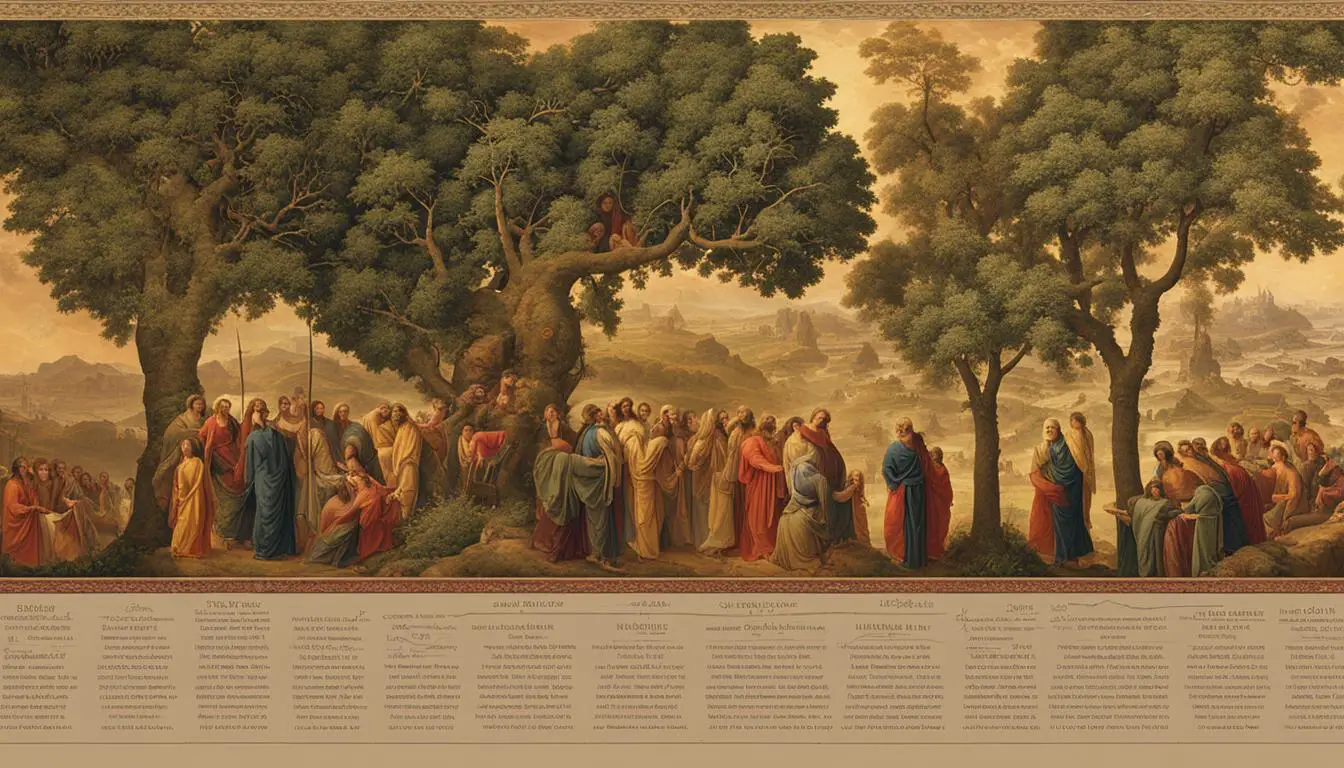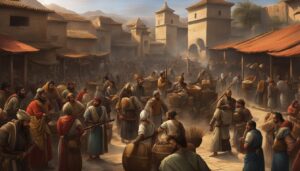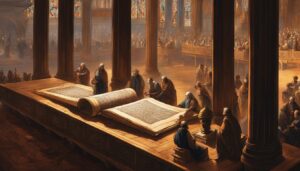
In the study of biblical history, understanding the chronology of events is essential. The alignment of biblical narratives with historical chronology allows us to grasp the significance of these accounts and their impact on human history. In this article, we will explore the challenges and methods of analyzing the chronology of biblical narratives, and how resolving the timeline conflict can provide a coherent understanding of biblical and human history.
Key Takeaways:
- Biblical narratives hold divine authority in their final canonical form.
- Historical accuracy is valuable but not essential for the faith conviction in the trustworthiness of biblical passages.
- Analyzing the chronology of biblical narratives can be challenging due to the lack of specific dates and external references.
- Resolving the timeline conflict requires trusting God’s Word as authoritative and recognizing the limitations of man’s fallible dating methods.
- The biblical timeline aligns with the biblical account of the Flood and the dispersion at Babel, providing a coherent understanding of biblical and human history.
Analyzing the Chronology of Biblical Narratives
One of the challenges in studying biblical narratives is analyzing their chronology to understand the sequence of events accurately. This task becomes particularly complex when it comes to the judges period in the Book of Judges. The timeline presented in the Bible does not align seamlessly with the total years given in Judges, creating a discrepancy that requires further examination.
The Book of Judges can be divided into four distinct segments: the Introduction, the Early Period, the Late Period, and the Appendix. Each segment provides valuable insights into the judges who delivered Israel from oppressors and the challenges they faced. However, the lack of specific dates and external reference points within these narratives makes it challenging to establish a precise chronology for this period.
Various attempts have been made by scholars to reconcile the chronology by filling in gaps and compressing the timeline. The Early Period of the Book of Judges focuses on the specific durations of oppressions and peace, providing some insight into the timeline. The Late Period offers a sequence of judges, although the level of historical detail varies. Additionally, the Appendix contains additional stories that are not explicitly dated to any judge but contribute to the overall narrative.
Table: Chronology of the Judges Period in the Book of Judges
| Judge | Duration |
|---|---|
| Othniel | 40 years |
| Ehud | 80 years |
| Shamgar | unknown |
| Deborah | 40 years |
| Gideon | 40 years |
| Abimelech | 3 years |
| Tola | 23 years |
| Jair | 22 years |
| Jephthah | 6 years |
| Ibzan | 7 years |
| Elon | 10 years |
| Abdon | 8 years |
| Samson | 20 years |
| Samuel (judge and prophet) | unknown |
The analysis of biblical narratives requires careful consideration of the available information and an understanding of the limitations in establishing a precise chronology. While challenges exist in aligning the chronological order of biblical events, continued research and scholarly efforts contribute to a more comprehensive understanding of the biblical timeline and the historical accuracy of biblical narratives.
Resolving the Timeline Conflict
When examining the chronology of biblical narratives, conflicts with historical events can arise. One such discrepancy occurs when comparing the biblical timeline with the construction of the pyramids in Egypt. However, by trusting God’s Word as authoritative, we can find resolution.
The biblical timeline places the Exodus around 1446 BC and the establishment of Egypt after the dispersion at Babel. Interestingly, the Tower of Babel may have influenced the construction of pyramidal structures in various ancient civilizations. It is important to note that secular timelines, based on man’s ideas, often suggest a much older age for Egypt and the pyramids.
By recognizing the limitations of man’s fallible dating methods and wholeheartedly trusting God’s Word, we can achieve a consistent interpretation of biblical history. The biblical timeline aligns not only with the biblical account of the Flood but also with the dispersion at Babel. This cohesive understanding provides us with a comprehensive view of both biblical and human history.
By putting our faith in the authority of Scripture and understanding the influence of biblical historical references, we can find harmony between the biblical narratives and historical events. It is through this lens that we gain a deeper appreciation for the intricate connections between biblical accounts and the broader scope of human civilization.
FAQ
What is the authority of the biblical text based on?
The authority of the biblical text is based on its final canonical form, as referred to by Jesus and the authors of the New Testament.
What does “God-breathed” nature of Scripture refer to?
The “God-breathed” nature of Scripture applies to the texts that were handed down and included in the canon.
Should historical-critical considerations affect the estimation of a passage’s divine authority?
No, historical-critical considerations should not affect the estimation of a passage’s divine authority.
Where is the meaning of a canonical passage found?
The meaning of a canonical passage is found within the text itself, not in its relation to “objective history”.
Is historical accuracy essential to the faith conviction in the trustworthiness of each passage?
While historical accuracy may have apologetic value, it is not essential to the faith conviction that each passage is trustworthy for its divine purposes.
What is the challenge in aligning the chronology of the judges period in the Book of Judges with the timeline presented in the Bible?
The total of the years given in Judges does not match the timeline from the Exodus to the reign of Solomon.
How have attempts been made to reconcile the chronology in the Book of Judges?
Various attempts have been made to reconcile the chronology by filling in gaps and compressing the timeline.
How can the Book of Judges be divided?
The Book of Judges can be divided into four segments: the Introduction, the Early Period, the Late Period, and the Appendix.
What does the Early Period in the Book of Judges focus on?
The Early Period focuses on the judges who delivered Israel from oppressors, with specific durations of both oppressions and peace.
What does the Late Period in the Book of Judges provide?
The Late Period provides a sequence of judges, with varying levels of historical detail.
Is establishing a precise chronology for the judges period in the Book of Judges challenging?
Yes, the lack of specific dates and external reference points make it challenging to establish precise chronology for this period.
How can the timeline conflict between biblical narratives and historical events be resolved?
The timeline conflict can be resolved by trusting God’s Word as authoritative.
What does the biblical timeline place the Exodus and the beginning of Egypt?
The biblical timeline places the Exodus around 1446 BC and the beginning of Egypt after the dispersion at Babel.
What may have influenced the construction of pyramidal structures in various ancient civilizations?
The Tower of Babel may have influenced the construction of pyramidal structures in various ancient civilizations.
What does the secular timeline suggest?
The secular timeline, based on man’s ideas, suggests a much older age for Egypt and the pyramids.
How can a consistent interpretation of biblical history be achieved?
Trusting God’s Word and recognizing the limitations of man’s fallible dating methods allows for a consistent interpretation of biblical history.
Does the biblical timeline align with the biblical account of the Flood and the dispersion at Babel?
Yes, the biblical timeline aligns with the biblical account of the Flood and the dispersion at Babel, providing a coherent understanding of biblical and human history.








